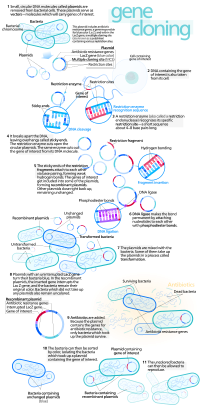
Photo from wikipedia
Abstract Horse (Equus caballus) and donkey (Equus asinus) species have been domesticated since about 6,000 years. The crossbreeding between horse and donkey gives mule (female horse × male donkey) and… Click to show full abstract
Abstract Horse (Equus caballus) and donkey (Equus asinus) species have been domesticated since about 6,000 years. The crossbreeding between horse and donkey gives mule (female horse × male donkey) and hinny (female donkey × male horse), the most famous equid hybrids in the world. Due to the absence of information highlights the genetic profiling of the mule and hinny, the present study aimed to differentiate between the two closely related hybrids in comparison with horse and donkey by DNA fingerprinting. Five blood samples were collected from each investigated group (horse, donkey, mule, and hinny) and tested by polymerase chain reaction (PCR) for partial amplification of cytochrome b (cyt‐b) gene. Furthermore, the amplified PCR products were digested via two restriction enzymes (Alu I and Hinf I) and sequenced. The Alu I enzyme yielded the same restriction pattern in all tested animals; in contrast, the Hinf I enzyme gave two patterns and grouped horse and mule in one group, as well as, donkey and hinny in another group. In addition, the nucleotide sequence analysis and phylogeny gave the same grouping as restriction analysis. It is concluded that restriction analysis using Hinf I enzyme and sequence analysis of partial cyt‐b gene can differentiate between two equid hybrids. Graphical Abstract Figure. No Caption available. HighlightsPolymerase chain reaction‐restriction fragment polymorphism of cytochrome b (cyt‐b) by Alu I cannot differentiate between two closely equid hybrids.Restriction fragment polymorphism by Hinf I endonuclease successfully discriminated among examined animal species.Polymerase chain reaction‐restriction fragment polymorphism by Hinf I and sequencing of cyt‐b discriminated the two equid hybrids.Genetic identity between horse and mule and between donkey and hinny was recorded.
Journal Title: Journal of Equine Veterinary Science
Year Published: 2017
Link to full text (if available)
Share on Social Media: Sign Up to like & get
recommendations!